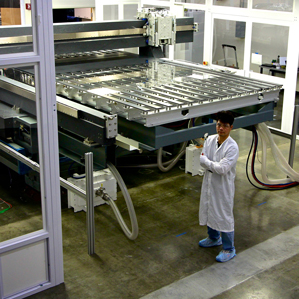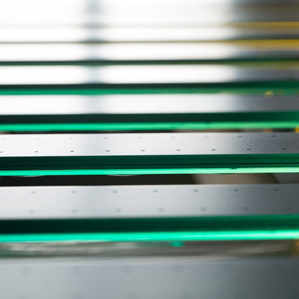Bendable Displays Are Finally Headed to Market
By the end of this year, a startup called Kateeva will start shipping manufacturing equipment that could finally bring flexible displays to market.

For years, designers have conjured up images of displays that could be rolled up. In January 2013, for instance, Samsung showed off a flexible screen at the Consumer Electronics Show in Las Vegas, offering visions of smart watches with displays that wrap around your wrist, or even gadgets that can be folded up and popped in a pocket.
But these prototypes have not been durable enough to commercialize. After unveiling its flexible display prototype, Samsung reportedly ran into trouble with the material for sealing the display—the organic LEDs (OLEDs) used in the display must be protected from water vapor and oxygen.
“Just a few molecules of oxygen or moisture can kill the display,” says Greg Raupp, an expert on display technology at Arizona State University. “So the encapsulation requirements for an OLED display are quite significant.”
Samsung has come out with curved phones that use flexible displays, but these have been fixed in place so that they can’t be bent, a format that is easier to seal. According to a statement from Samsung, the company does not have “any challenge encapsulating OLED materials” in these mass-produced phones.
Kateeva has developed an inkjet printing process that can apply a protective coating to OLEDs far faster than previous methods. This promises to cut manufacturing costs in half, and make it possible to integrate the process into existing production lines more easily.

Adding touch to a flexible display is another challenge. Indium tin oxide (ITO), the transparent, conductive material that’s used in touch displays, is brittle, and will crack in a flexible display. Canatu, based in Helsinki, Finland, makes thin films covered with a network of carbon nanobuds (a nanotube with a sphere of carbon atoms attached to it) for flexible touch displays. The nanobuds have better conductivity than conventional nanotubes, and can be both stretched and curved around a radius as thin as a millimeter. The company opened a factory last year to produce the materials and has shipped it to 30 customers for making prototype devices.
Raupp says Samsung and other phone makers are taking a conservative approach, starting with curved displays that can’t be bent to make sure the flexible screens inside them work well. He says the first truly flexible displays will probably be in designs that control how much they can be folded, to prevent damage to the display. “All the major manufacturers are working on foldable displays,” he says.
This story was updated at 10:23 am with a statement from Samsung.
Keep Reading
Most Popular
Large language models can do jaw-dropping things. But nobody knows exactly why.
And that's a problem. Figuring it out is one of the biggest scientific puzzles of our time and a crucial step towards controlling more powerful future models.
How scientists traced a mysterious covid case back to six toilets
When wastewater surveillance turns into a hunt for a single infected individual, the ethics get tricky.
The problem with plug-in hybrids? Their drivers.
Plug-in hybrids are often sold as a transition to EVs, but new data from Europe shows we’re still underestimating the emissions they produce.
Stay connected
Get the latest updates from
MIT Technology Review
Discover special offers, top stories, upcoming events, and more.